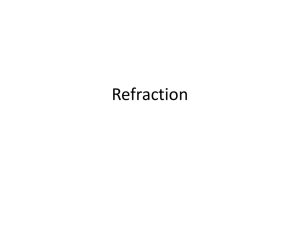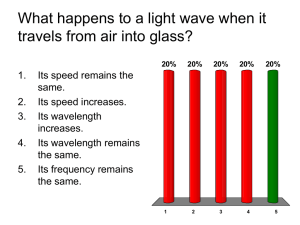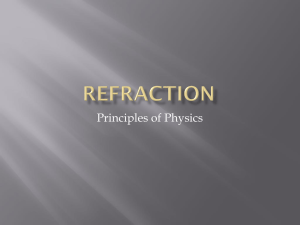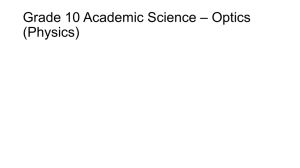Ex. 50 PowerPoint
advertisement
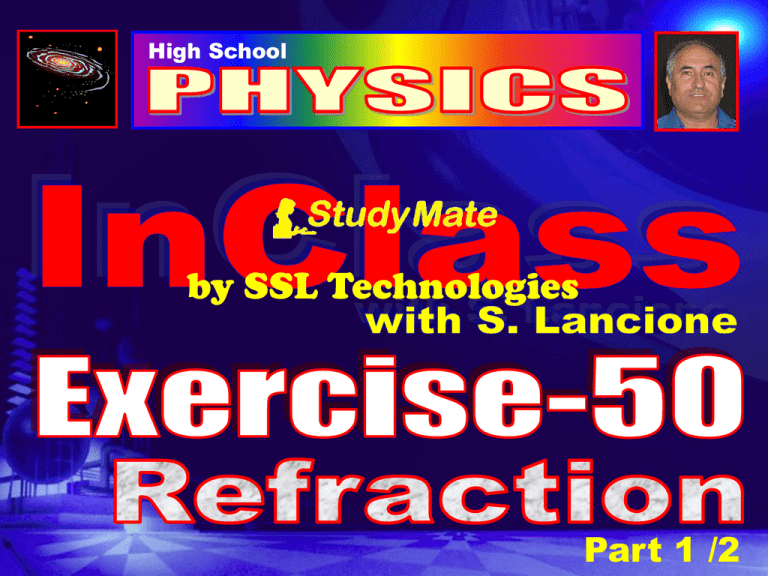
High School by SSL Technologies Part 1 /2 Physics Ex-50 PART-1 /2 INDEX OF REFRACTION The optical density of a transparent medium (material) is an inverse measure of the speed of light through the medium. The more optically dense a transparent medium is, the slower the speed of light travels in that medium. Reminder : The speed of light in a vacuum is 3 x 108 m/s. The speed of light in air is very close to the speed of light in a vacuum. We assume the speed of light in air is “c” or 3 x 108 m/s. Click Physics Ex-50 PART-1 Refraction is the bending of light rays as they pass from one medium into another medium of different optical density. The index of refraction of a transparent medium is a ratio of the speed of light in a vacuum to the speed of light in the medium: n = c/v where n = is the index of refraction (no units) c = 3 x 108 m/s v = speed of light in the medium (in m/s) Note : The greater the index of refraction of a medium, the slower light travels in that medium. The index of refraction for a vacuum is one (1), for water it is 1.33, for diamond it is 2.42, etc. Click Physics Ex-50 PART-1 When refraction occurs, light bends away from the normal when the optical density (index of refraction) is less dense (and vice versa). The following illustration demonstrates this fact: n1 = 1 Normal n2 = 1.5 n1 < n2 n1 = 1.5 Normal n2 = 1 n1 > n2 Click Physics Ex-50 PART-1 SNELL’S LAW Snell’s Law describes the relationship between the angle of incidence and the angle of refraction when refraction occurs. Mathematically, Snells’s Law is written as: n1 Sin io where n1 n2 io ro = n2 Sin ro = = = = index of refraction of medium-one (incident ray) index of refraction of medium-two (refracted ray) angle of incidence angle of refraction Click Question-1 Physics Ex-50 Define refraction and explain how it differs from reflection. Reflection is the bending of light with the incident ray and the reflected ray being in the same medium (there is only one medium). Refraction is the bending of light as it passes from one medium into another medium (there are two “mediums”). Click Question-2 Physics Ex-50 Define what is meant by the optical density of a medium. The optical density of a medium refers to the speed of light in that medium. The greater the optical density of a medium , the greater the index of refraction and the slower light travels in that medium. Click Question-3 Physics Ex-50 Does the speed of light increase or decrease as the optical density of a medium increases ? The speed of light decreases as the optical density increases. Click Question-4 Physics Ex-50 Explain what is meant by the index of refraction of a medium. The index of reflection (n) of a medium is the ratio of the speed of light in that medium to the speed of light in a vacuum (or air). The greater the index of refraction of a medium, the slower light will travel in that medium. Note that the index of refraction (n) has no units as it is simply a ratio. Click Question-5 Physics Ex-50 State Snell’s Law. Click Question-6 Physics Ex-50 What is the purpose of Snell’s Law? The purpose of Snell’s Law is to calculate the angle of refraction given the angle of incidence and vice-versa. Click Question-7 Physics Ex-50 The speed of light in a Plexiglas is 2.1 x 108 m/s. Calculate the index of refraction for this Plexiglas. Click Question-8 Physics Ex-50 The diagrams below illustrate a ray of light traveling from one medium to another. In the first case, light travels from a lesser to a greater density medium (air to glass). In the second case, light travels from a denser to a less dense medium (glass to air). Draw the refracted ray for each case. Towards normal Away from normal Click Question-9 Physics Ex-50 A ray of light enters a transparent material at an angle of incidence of 45o. If the angle of refraction is 28o, what is the index of refraction of the substance? Click Question-10 Physics Ex-50 Knowing that the index of refraction for diamond is 2.42, calculate the speed of light in diamond. Click Question-11 Physics Ex-50 A ray of light enters water at an angle of incidence of 30o. The angle of refraction is found to be 22o. Calculate the index of refraction for water. Click Question-12 Physics Ex-50 In traveling from air into water (n = 1.33), a ray of light makes an angle of incidence of 52o. Calculate the angle of refraction. Click Question-13 Physics Ex-50 In traveling from water into air, a ray of light makes an angle of refraction of 59o. Calculate the angle of incidence. Click Question-14 Physics Ex-50 A ray of light emerges from water into air with an angle of incidence of 22o. What is the angle of refraction? Click Question-15 Physics Ex-50 The index of refraction of flint glass is 1.63. Find the angle of incidence for a ray of light entering flint glass from air such tha the angle of refraction is 35o. Click Question-16 Physics Ex-50 A light ray passes through two liquids, one floating on top of the other, in a beaker. The angle of refraction in the water is 25o (see diagram). Determine the angle of incidence (Ao). Click SSLTechnologies.com/science

